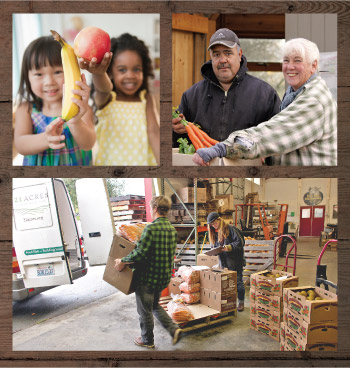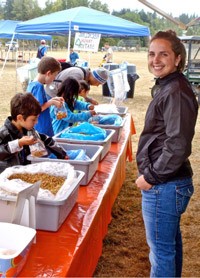Seattle's Food Action Plan
by Bill Thorness
This article was originally published in December 2013

Several programs aim to get local, sustainable food to more people in our community.
Eating healthy food, grown locally. Supporting our local economy. Wasting less. Those are likely the watchwords of a PCC member, but they’re also the tenets of Seattle’s Food Action Plan (FAP).
Released in October 2012, four years after the city council passed the Local Food Action Initiative, the FAP is a set of policy directives aiming to get local food to more Seattle residents, reduce conditions such as food deserts and food inequalities, and create a more sustainable local food system.
In a child-care agency kitchen, people learn how to pair herbs with freshly cooked produce, or how to make vegetables palatable to kids by “hiding” them in tasty tomato sauce for pasta.
When volunteers finish serving a group dinner to elders, each takes home a bag of fresh, local produce, accompanied by a sheet of recipes.
These are images from a quiet food revolution. Far from the contest by top chefs to outdo each other in new restaurants or funky food trucks, it’s an effort to spread the food wealth.
Enabling food access
A year into the FAP, the plan is piloting innovative programs that connect local farmers with new customers, help more low-income people enjoy our region’s agricultural bounty, and put healthy, local food in front of some of the most vulnerable people in our communities: children and elders who get meals through social-service programs.
“It has grown into a completely healthy atmosphere here,” observes Jacqueline Boles, director of Family and Health Services at Tiny Tots Development Center, a preschool and child-care agency that serves 400 families at five sites in South Seattle and is participating in a pilot program called Farm to Table.
The agency has embraced local food and nutrition issues, with visible results. Gardening and farm field trips have become part of the learning and play for the children. The fresh meals — breakfast, lunch and snacks — are making the center a sought-after placement.
Staff members are learning to cook with a rainbow of new or different vegetables and fruits, which is having an effect on their health as well. “It has brought in an awareness I never thought I would see,” says Boles. “We’re being conscious now of our diet.”
Linking meal sites to farms
Those are gratifying results, says Sharon Lerman, food policy advisor in the Seattle Office of Sustainability and Environment. “We saw this relationship with child-care providers as a unique opportunity to work with them to help children develop healthy food habits.”
Farm to Table exposes people who provide meal services — from senior community dinners to child-care breakfasts to hospital cafeteria lunches — to the seasonally available produce from local farms. In the process, it teaches people about unfamiliar foods.
“The best part is learning the different types of vegetables,” says Boles.
The process begins with an innovative, grant-funded, website ordering system set up by the Northwest Agriculture Business Center (NABC) that replicates the massive procurement process of institutional buyers, but on a small scale. The site enables small producers to list their produce each week for meal providers to review and order. Then the produce is aggregated and delivered to each buyer’s location.
Streamlining the process has made it easy for many more meal sites, which have a variety of ordering practices, to get their hands on local food.

PCC and the FAP
There are lots of ways PCC supports the FAP’s mission to get healthy, local food to low-income people in our community:
- PCC Food Bank Program: With donations from our shoppers, PCC purchases nutritious bulk foods that are most needed at food banks, including grains, beans, pasta, raisins, pancake mix and much more at discounted wholesale prices. As of September, we had raised $81,362.86 this year alone. Please participate in our winter food drive going on all this month.
- Free fruit for kids: Kids 12 and younger get a free piece of fruit every time they visit PCC.
- PCC Healthy Kids initiative: Our staff, vendors and key partner organizations including Seattle Parks and Recreation, Seattle Children’s Hospital and Solid Ground team up to teach healthy habits and to improve the diets of local children through numerous programs and events.
- Nutrition education and outreach: PCC invites groups into our stores for free tours, responds to requests for food and nutrition education in the community, and informs our members about current food and nutrition issues and controversies.
For small agencies, “to get a bulk order from a farm was new to them,” says Natalie Thomson, education specialist with the city’s Department of Human Services. “Many of them were shopping at Costco, Cash & Carry and Safeway.” It’s also common practice for meal service providers just to buy prepared food and reheat it.
Even for larger institutions, buying local has not been on their radar screen, but when they do it, people respond. “People are lining up for lunch on ‘Farm-fresh Friday’ at the local hospital,” says NABC’s Lucy Norris. “UW Medical Center says it’s doing 25 percent local now, and that’s huge.”
But sometimes, thinking globally can prevent people from acting locally. With a system built to ship food around the world, “we lack the infrastructure to support regional commerce,” Norris says. It hits small producers, who may have scant staff time and just a small quantity of produce for sale, especially hard.
The NABC’s solution was to embrace the “food hub” model, where farmers can take their produce to a central location and all the orders will be loaded together on one truck. The first food hub was in Woodinville, and a second opened this summer in the Skagit Valley.
“It’s a collaborative, cooperative model that farmers are really getting used to,” says Norris. For customers, it’s simple and convenient. They might get produce from five farmers, but it will all come into their kitchen in one delivery.
“These programs are very satisfying,” says Marijke Postema, co-owner of Maltby Produce Markets in Snohomish County, recalling the feeling “when we are packing [produce] and know it is going to someone who has never seen Brussels sprouts before, or parsnips or kale.”
While Farm to Table is challenging for small producers, some are finding new types of clients. The program has grown from serving eight to 40 of the “highest need” child care sites, and expansion is expected to continue. It’s still only a fraction of 300 such sites in Seattle and 1,600 total in King County. About 20 organizations that provide meals to elders are using the program.
Expanding “Fresh Bucks”
The Farm to Table program offers a new route for small farmers to get their produce to city buyers, but many farmers already are doing that weekly at our many farmers markets. Another program in the Food Action Plan, called “Fresh Bucks,” uses the farmers market connection to get healthy, local produce to people who use food assistance programs.
“Fresh Bucks is a nutrition incentive program that doubles the purchasing power for low-income residents who use their federal food stamp benefits to purchase fresh fruits and vegetables at farmers markets,” Lerman explains. For every market day, shoppers using SNAP cards (aka food stamps) can get up to an additional $10 in credits to use on farmers’ produce.
In its first year in 2012, the program “helped about 1,500 low-income shoppers, including about 900 who had never shopped at farmers markets before” at seven markets, says Lerman. This year, the program was rolled out to all 15 farmers markets in July. By mid-October, about 2,500 low-income shoppers had spent nearly $83,000 at the markets, more than $57,000 of that total coming from Fresh Bucks. Using the U.S. Department of Agriculture’s SNAP input-output multiplier, SNAP plus Fresh Bucks transactions amounted to an estimated $250,000 in economic stimulus, Lerman says.
Many FAP angles
While Fresh Bucks and Farm to Table are two visible programs underway, there are other aspects to the Food Action Plan’s goal of improving access to healthy food and supporting a sustainable local food economy. Some programs existed or are being created in parallel with the FAP, but “the FAP brings those together and articulates a common vision that we can embrace across departments, and that the community can embrace,” Lerman explains.
For instance, Seattle Parks and Recreation started its own healthy food initiative, and its vision is being expanded into eating more healthy food at community centers and growing more food in parks. The city just adopted a “healthy vending” policy, already in place at parks department locations, that will extend healthy vending practices to all city properties. The food hub concept is being expanded to community centers, which could host community kitchens or Community Supported Agriculture drop-off sites.
In addition, the P-Patch Program has seen great growth, spurred by the recent parks levy, and now is providing space for residents to grow food in nearly 90 gardens, up from 70 in 2009. Also, the new “Seattle Farms” program will identify city-owned properties that could be leased to people wanting to be commercial urban farmers.
Whatever the funding source or department, it’s all about the food for the tiny tots on a field trip to their local P-Patch or the immigrant elders who learn to cook new types of produce at a community center kitchen. Although the city’s actions to spread our food wealth are still being piloted, the plan holds promise for small, regional farmers and those who value — or are just discovering — local food.
Bill Thorness is a Seattle writer and author of Cool Season Gardener.
